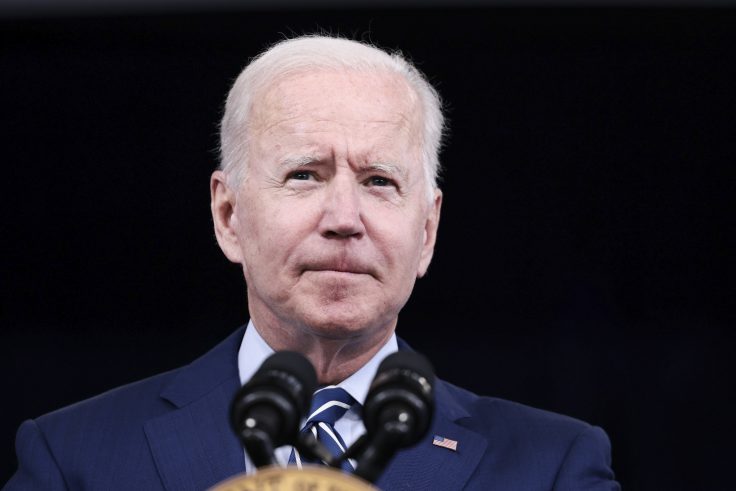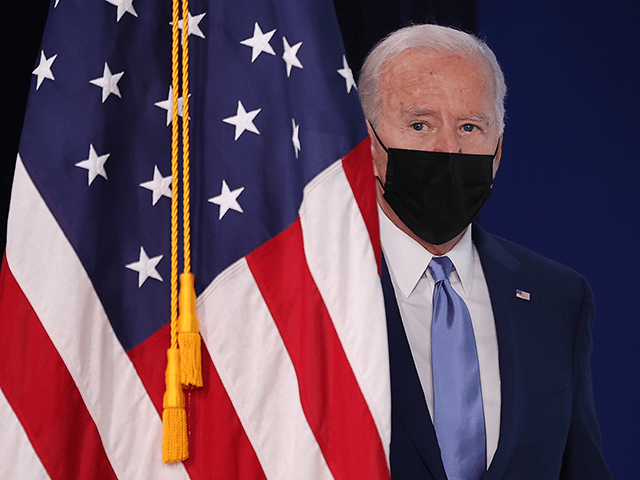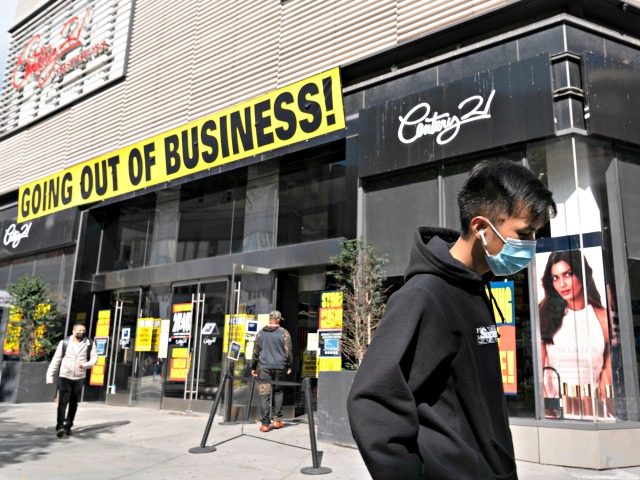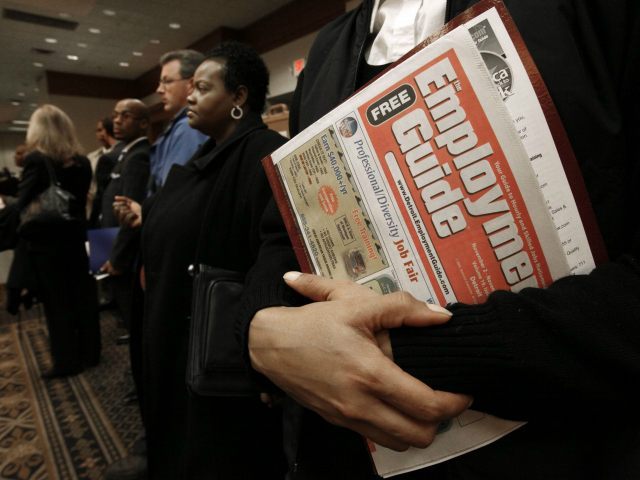This, along with the disastrous job situation where upwards of 7.5 million unemployed workers have been cut off jobless benefits, millions are at risk of being thrown out of their homes with the lapsing of the national eviction moratorium, accompanied with skyrocketing home and rental costs that are bound to drive both an immiseration and radicalization of the working class.
BIDENOMICS FOR THE RICH: KEEP WAGES DEPRESSED WITH HUNDREDS OF THOUSANDS OF ILLEGALS WHO CAN'T SPEAK ENGLISH AND PROBABLY NEVER WILL. JUST LOOK AT MEXIFORNIA!
Raymond Arroyo: The collapsing presidency of Joe Biden
https://www.youtube.com/watch?v=CAeGDQOET3Q
Biden Posts Worst Jobs Report Since 2020
New jobs fell 300,000 short of Dow Jones estimate

The economy createe.com/watch?v=CAeGDQOET3Qd just 194,000 jobs last month, marking its worst performance since December 2020, the Labor Department reported Friday.
The latest job numbers are down from 366,000 added in August and fell more than 300,000 short of the Dow Jones estimate. While the unemployment rate fell to 4.8 percent from 5.2, the labor participation rate ticked down to 61.6 percent—compared with 63.4 percent in January 2020—indicating many Americans are leaving the workforce. While the unemployment rate for women dropped 0.6 percent, the group lost a net 26,000 jobs in September.
A loss of more than 100,000 government jobs, particularly at public schools, contributed to the modest employment figures, as many school districts face COVID-related closures. The weak employment numbers are raising alarms that the economy is struggling with significant labor shortages.
"This was the time when a lot of people were expecting labor shortages to be getting better but in fact they're getting worse," Michael Pearce, senior U.S. economist at Capital Economics, told the Wall Street Journal. "It's a pretty worrying situation."
The tight labor market is pushing up wages, which increased 0.6 percent last month. Elevated wages could worsen the country's inflation surge, which, coupled with stagnant job growth, has prompted some analysts to warn about the return of "stagflation," which crippled the U.S. economy in the 1970s.
"Now one can make a case that ‘mild' stagflation is already underway," New York University economist Nouriel Roubini wrote in an August column. "Inflation is rising in the United States and many advanced economies, and growth is slowing sharply, despite massive monetary, credit, and fiscal stimulus."
The disappointing jobs report comes as the Biden administration prepares to enforce its vaccine mandate, which would require employees at businesses with more than 100 workers and federal agencies to receive coronavirus vaccines.
Jobs Creators Network Slams Biden’s Weak Jobs Report: ‘Worst Jobs Report of the Year’

The Jobs Creators Network reacted to President Joe Biden’s terrible jobs report, blaming his “failed policies” and radical agenda for “wrecking small businesses” across the country.
“This was the worst jobs report of the year and a clear indictment of President Biden’s failed policies,” the President and CEO of the Job Creators Network, Alfredo Ortiz, said in a statement on Friday, shortly after the job numbers were released.

U.S. President Joe Biden takes the stage before delivering remarks on the September jobs numbers in the South Court Auditorium in the Eisenhower Executive Office Building on October 08, 2021, in Washington, DC. According to the U.S. Labor Department, the economy added a disappointing 194,000 jobs in September as the COVID-19 Delta variant negatively impacted the usual annual hiring patterns. (Photo by Chip Somodevilla/Getty Images)
“Even the termination of Biden’s overly-generous unemployment benefits – which kept workers on the sidelines for almost half a year – failed to stimulate job growth because Biden’s agenda is wrecking small businesses,” Ortiz added. “Higher taxes, vaccine mandates, record spending triggering rapid inflation – this is all part of Biden’s ‘War on Small Business.'”
The jobs report from the Labor Department was released on Friday, showing the disastrous report for Biden. The U.S. economy only added 194,000 jobs in September, along with the unemployment rate only falling by 0.4 percent (4.8 percent total).
“The sluggish pace of jobs created surprised experts again, as they predicted about 500,000 jobs created, but the economy fell short again,” Breitbart News’s Charlie Spiering noted. “The jobs numbers were expected to rise significantly in September, as expanded unemployment checks from the federal government expired.”
Additionally, the labor force participation went down slightly in September as well, 61.7 percent from the 61.8 percent in August.
Overall, the poor jobs numbers show that the U.S. economy is not back to normal, considering some of the industries performed even worse than in August.
The Job Creators Network has been trying to highlight Biden’s war of small businesses by having a national bus toured — Bring Small Businesses Back Bus Tour — to promote pro-growth policies as an alternative to Biden’s “failed policies.”
Follow Jacob Bliss on Twitter @jacobmbliss.
EXCLUSIVE: Significant Spike in Migrant Traffic Headed to Arizona Border

The Yuma Sector in Arizona is on the cusp of surpassing the Del Rio Sector in Texas. Yuma Sector agents report a spike in migrant apprehensions only days into FY22 which began on October 1.
A source operating under the umbrella of U.S. Customs and Border Protection told Breitbart Texas that Yuma Sector agents apprehended more than 5,000 migrants during the first seven days of the new fiscal year. Most migrants are converging near the Morelos Dam, west of Yuma, where the Colorado River is extremely shallow. This makes for easy entry into the United States where the migrants promptly surrender to Border Patrol agents.

Yuma Sector agents report a growing surge of Central American migrants crossing the border from Mexico during the first days of FY22. (Photo: U.S. Border Patrol/Yuma Sector)
The trend has been building steadily over the past few months and is in stark contrast to previous years when the Yuma Sector was ranked nearly last in border apprehensions. In FY 2020, 8,804 migrants were apprehended throughout the sector. The source says they are now seeing that number exceeded every two weeks.
The migrants, mostly from Central America, cross in large groups for the most part and consist of family units and unaccompanied migrant children. On Tuesday, a group of 171 migrants entered near the Morelos Dam and surrendered to awaiting agents. This is now a common occurrence in the area.

Photo: U.S. Border Patrol/Yuma Sector
The source says agency intelligence indicates migrant shelters are filling in Sonora, Mexico, and are a sign that an increase in activity for Yuma Sector is imminent.
The Mexican train, known as “La Bestia” or “The Beast” travels from southern Mexico to the United States border and has offshoot rail lines leading to the border state of Sonora. The source says migrant traffic on the rail line is also increasing steadily.
“That line, we hear, is experiencing more traffic than usual. We are starting to see some Haitian migrants starting to head this way as well”, the source, speaking on condition of anonymity, told Breitbart Texas. The rising apprehension numbers in Yuma put the sector in a solid third place, just behind the Border Patrol’s Del Rio Sector.
According to the source, with more than 5,000 apprehensions during the first week of the new fiscal year, the Yuma Sector was behind the Del Rio sector by only 500 migrant apprehensions. Del Rio garnered significant media attention recently due to a surge in mostly Haitian migrants that overwhelmed agents there.
The Yuma Sector also experienced migrant surges in years past. The most significant surge garnered national attention in 2005. That year, Yuma Sector led the southwest border sectors in apprehensions, with more than 138,000 crossing the border illegally. The demographic at the time consisted of largely single adults seeking to elude apprehension.
In response, significant infrastructure investments and staffing augmentation by the George W. Bush administration resulted in a significant reduction to migrant traffic in the area. Apprehensions dropped from their peak of 138,428 in 2005 to 8,363 some three years later.
The government constructed more than 38 miles of primary border fencing, 8 miles of secondary fencing, and an additional layer of 8 miles of tertiary fencing surrounding Yuma to achieve the results. Nearly 12 miles of all-weather roads were also constructed to allow for easier patrol access to increase the likelihood of apprehending migrants intending to escape from the Border Patrol. An additional 6,000 Border Patrol agents were hired and posted across the southwest border simultaneously.
Currently facing different demographics — migrant family units and unaccompanied migrant children seeking to surrender — the infrastructure fails to serve as a deterrent. Policy changes regarding pathways to removal under the current administration are the pull factors driving the surge according to the source.
The source says that only a small minority of the migrants apprehended in Yuma are being expelled to Mexico under the Trump era Title 42 COVID-19 authority. Of the more than 5,000 migrants apprehended over the course of seven days, the source says less than 200 were swiftly expelled to Mexico under the emergency order.
More than 4,800 were processed under traditional legal pathways allowing the migrant family units and unaccompanied migrants to pursue asylum claims. The source says most are released into the United States as they await the adjudication of their asylum claims.
Randy Clark is a 32-year veteran of the United States Border Patrol. Prior to his retirement, he served as the Division Chief for Law Enforcement Operations, directing operations for nine Border Patrol Stations within the Del Rio, Texas, Sector. Follow him on Twitter @RandyClarkBBTX.
The pandemic pushed millions of U.S. workers to join the 'Great Resignation.' Here's why
BIDENOMICS: THE RICH GET MUCH, MUCH RICHER AND ILLEGALS GET THE JOBS.
MIDDLE AMERICA GETS THE SHAFT AND THE TAX BILLS TO COVER THE LA RAZA
WELFARE STATE AND THE CRIMES PERPETRATED BY THE RICH AND WALL STREET
The growth of hunger during the pandemic is a damning exposure of the incapability of capitalism to provide for even the most basic of social needs and an objective expression of the need for the working class to expropriate the wealth of the capitalist oligarchs and to put it towards the needs of the vast majority of the population.
Poll: Americans More Concerned with Jobs, Economy than the Coronavirus

Americans are more concerned with jobs and the economy than the Chinese coronavirus, an Ipsos survey released Thursday found.
The survey asked respondents to rate the “most important problem facing the U.S. today.”
A plurality, 22 percent, chose the “economy, unemployment, and jobs,” as the leading problem facing America. Thirteen percent chose public health, disease, and illness, followed by immigration (12 percent), the healthcare system (9 percent), the environment and climate (8 percent), inequality and discrimination (6 percent), crime or corruption (6 percent), terrorism and extremism (4 percent), and education (4 percent). The remaining causes saw three percent support or less.
That issue — the economy, unemployment, and jobs — also leads across party lines, as 27 percent of Republicans chose it, as did 29 percent of independents and 16 percent of Democrats. However, 16 percent of Democrats also chose public health, disease, and illness.
The survey, taken October 6-7, 2021, among 1,005 U.S. adults, has a margin of error of +/- 3.5 percent.
It coincides with Friday’s lackluster jobs numbers released by the Labor Department, showing the U.S. adding 194,000 jobs in September.
As Breitbart News reported:
The September numbers are even worse than the disastrous report from August, showing only 235,000 jobs created. (August’s reported gains were revised up, however, from 235,000 to 366,000.)
The sluggish pace of jobs created surprised experts again, as they predicted about 500,000 jobs created, but the economy fell short again.
Meanwhile, Biden’s approval rating continues to sink underwater as several polls released in the last few weeks show.


No comments:
Post a Comment